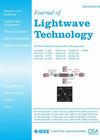Neuromorphic Photonic Spiking Neural Network for Medical Data Classification Based on VCSEL-SA
IF 4.8
1区 工程技术
Q2 ENGINEERING, ELECTRICAL & ELECTRONIC
引用次数: 0
Abstract
Neuromorphic photonic computinghas emerged as a transformative approach in information processing and artificial intelligence, leveraging its inherent advantages of high bandwidth and low latency. In this study, we present an energy-efficient photonic spiking neural network (PSNN) that utilizes a threshold- based encoding scheme to convert medical data into optical stimulus pulses. These pulses are processed through vertical cavity surface-emitting lasers with an embedded saturable absorber (VCSELs-SA), effectively emulating biological synaptic transmission for classification tasks. The network is trained using the Remote Supervised Method (ReSuMe), a supervised learning algorithm that optimizes synaptic weights to align the output spike and the target spike. Combined with Spike Timing-Dependent Plasticity (STDP), the system demonstrates exceptional classification performance on benchmark medical datasets, achieving training set accuracies of 95.6% and 97.9% on the Pima Indian Diabetes and Wisconsin Breast Cancer datasets, respectively. These results not only validate the efficacy and reliability of our proposed PSNN but also underscore its potential for advanced medical data analysis. To the best of our knowledge, this study represents the first application of PSNN for medical dataset classification. Furthermore, this work expands the application scope of PSNN, highlighting their promise for broader adoption in the medical field as photonic computing technology continues to evolve.基于VCSEL-SA的神经形态光子脉冲神经网络医学数据分类
神经形态光子计算利用其固有的高带宽和低延迟优势,已成为信息处理和人工智能领域的一种变革性方法。在这项研究中,我们提出了一种节能的光子脉冲神经网络(PSNN),该网络利用基于阈值的编码方案将医疗数据转换为光刺激脉冲。这些脉冲通过带有嵌入式饱和吸收器(VCSELs-SA)的垂直腔面发射激光器进行处理,有效地模拟了生物突触传输的分类任务。该网络使用远程监督方法(ReSuMe)进行训练,这是一种监督学习算法,可优化突触权重以使输出尖峰和目标尖峰对齐。结合Spike time - dependent Plasticity (STDP),该系统在基准医疗数据集上表现出优异的分类性能,在皮马印第安人糖尿病和威斯康星乳腺癌数据集上分别实现了95.6%和97.9%的训练集准确率。这些结果不仅验证了我们提出的PSNN的有效性和可靠性,而且强调了它在高级医疗数据分析方面的潜力。据我们所知,这项研究代表了PSNN在医学数据集分类中的首次应用。此外,这项工作扩大了PSNN的应用范围,随着光子计算技术的不断发展,PSNN有望在医疗领域得到更广泛的应用。
本文章由计算机程序翻译,如有差异,请以英文原文为准。
求助全文
约1分钟内获得全文
求助全文
来源期刊

Journal of Lightwave Technology
工程技术-工程:电子与电气
CiteScore
9.40
自引率
14.90%
发文量
936
审稿时长
3.9 months
期刊介绍:
The Journal of Lightwave Technology is comprised of original contributions, both regular papers and letters, covering work in all aspects of optical guided-wave science, technology, and engineering. Manuscripts are solicited which report original theoretical and/or experimental results which advance the technological base of guided-wave technology. Tutorial and review papers are by invitation only. Topics of interest include the following: fiber and cable technologies, active and passive guided-wave componentry (light sources, detectors, repeaters, switches, fiber sensors, etc.); integrated optics and optoelectronics; and systems, subsystems, new applications and unique field trials. System oriented manuscripts should be concerned with systems which perform a function not previously available, out-perform previously established systems, or represent enhancements in the state of the art in general.
 求助内容:
求助内容: 应助结果提醒方式:
应助结果提醒方式:


